Marimo moss ball (Aegagrophila linnaei) is not one of aquatic higher plants, it is not even a moss. It is a type of algae that provided with some specific conditions becomes a ball-shaped one. Marimo moss balls gained popularity among aquarists due to their unusual shape, unpretentiousness, the ability to dwell in various tanks and purify the tank water at the same time. However, there are several rules you should follow to avoid any issues when keeping this algae in a tank. You will find out what these rules are from our article today.
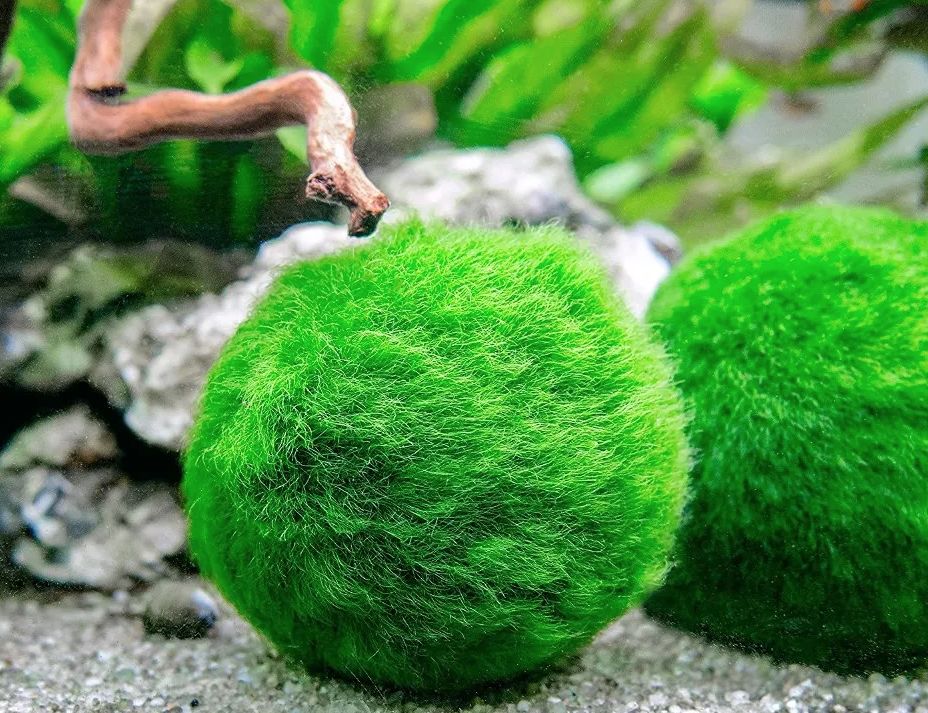
Contents
Morphology
Carl Linnaeus was the fist scientist to describe this algae in 1753 and called it Confevra aegagrophila. In 1843 taxonomists renamed it to Aegagrophila linnaei, and then to Cladophora aegagrophila.
The thing is, that this plant has been renamed and qualified many times as various plant kinds. Nowadays plant biologists consider that the marimo moss ball is from Cladophoraceae family, though it had been Cladophora family before.
However, after studying the plant DNA the scientists haven’t found any characteristics peculiar to Cladophora genus and beginning from 2002 they started calling as Aegagrophila linnaei again.
You may encounter the same diversity of the plant names in English as well. Here, the plant is called Cladophora ball, lake ball, mossimo, moss ball, marimo moss ball.
Plant Habitat in the wild
Representatives of Aegagrophila genus (which according to various estimations numbers from 40 to 170 kinds of algae) have acclimatized both to fresh and brackish waters of middle and tropical latitudes. All of the plant kinds prefer shallow waters, high level of illumination, clean and transparent water.
Nowadays, the marimo moss balls can be encountered in some water basins in the Baltic states, Scandinavian countries, Russia, Germany and Japan. Marimo moss is native to several locations, including Lake Akan in Japan, Lake Mývatn in Iceland, Lake Klamath in Oregon (USA), and Lake Aitōluoto in Estonia. In some locations, Marimo moss is considered a protected or endangered species due to overharvesting and environmental factors. Conservation efforts aim to preserve and restore their natural habitats.
Marimo moss is typically found in freshwater bodies, particularly in areas with cooler temperatures and moderate water movement. These environments provide the ideal conditions for Marimo moss growth.
Marimo moss starts as small fragments of algae that roll and tumble along the lake or riverbed. Over time, these fragments accumulate layers of algae, forming the characteristic spherical shape. Marimo moss is often found in the shallower areas of lakes or rivers, where sunlight can penetrate to support photosynthesis. These areas typically have lower water flow and offer a stable substrate for Marimo moss attachment.
Marimo moss can form colonies or clusters, where multiple individual moss balls grow in close proximity to one another. These clusters can create unique and visually striking natural formations.
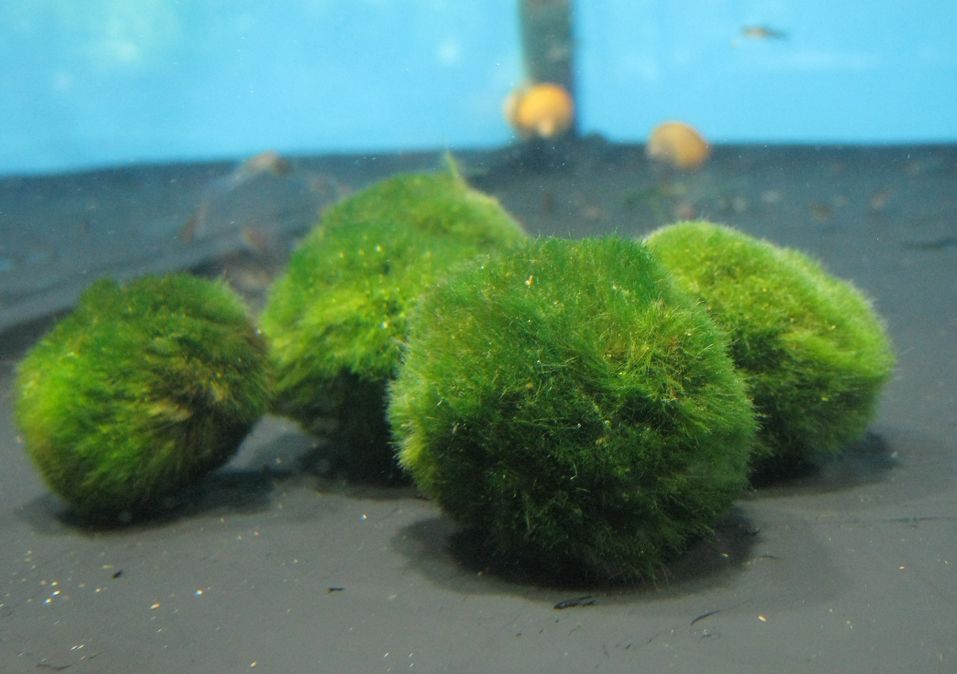
Description
Marimo moss is an epiphyte, which means it grows attached to surfaces such as rocks, driftwood, or other underwater structures. It can also grow attached to submerged vegetation.
Marimo moss ball is a colony of green algae that has some attached bushes consisting of branching filaments made from one row of multinucleate cells with multilayered shell and a reticulate chloroplast. The bushes can grow as a pillowlike, semi-sphere or spherical colonies.
Marimo moss ball size can reach up to 15 cm in diameter if it is a spherical shaped kind of the plant and its size is unlimited when the whole water basin bottom becomes covered with balls.
Large balls of the plant growing in tanks, which develop during several years, are hollow from the inside. Therefore a thick colony of the plants develops like a shell of a ball. If you cut one of such balls into halves, you’ll see its annual growth zones.
Spherical shape of the plant allows it to move along the bottom together with the water flow, which guarantees that the process of photosynthesis won’t be interrupted regardless of which side of the plant is now exposed to the sunlight. However, somewhere on the pond bottom these balls form even two-three layers one upon another!
And each of the balls needs light. Balls are green both outside as well as inside. There the ball is covered with a layer of inactivated chloroplasts, which become active, if the algae falls into pieces.
| Characteristic | Description |
|---|---|
| Appearance | Spherical green balls with a soft, velvety texture |
| Scientific Name | Aegagropila linnaei |
| Common Names | Marimo moss, Moss balls, Lake balls |
| Family | Cladophoraceae |
| Native Habitat | Freshwater lakes and rivers in Japan, Iceland, and Estonia |
| Growth Rate | Slow (expands a few millimeters per year) |
| Light Requirements | Adaptable to a range of lighting conditions |
| Water Temperature | Prefer cooler temperatures (68°F to 77°F / 20°C to 25°C) |
| Water Movement | Thrive in areas with gentle water movement |
| Care Level | Very low maintenance and easy to care for |
| Propagation | Reproduces by division, fragments grow into new moss balls |
| Environmental Benefits | Oxygenates water, absorbs nitrates, provides grazing area |
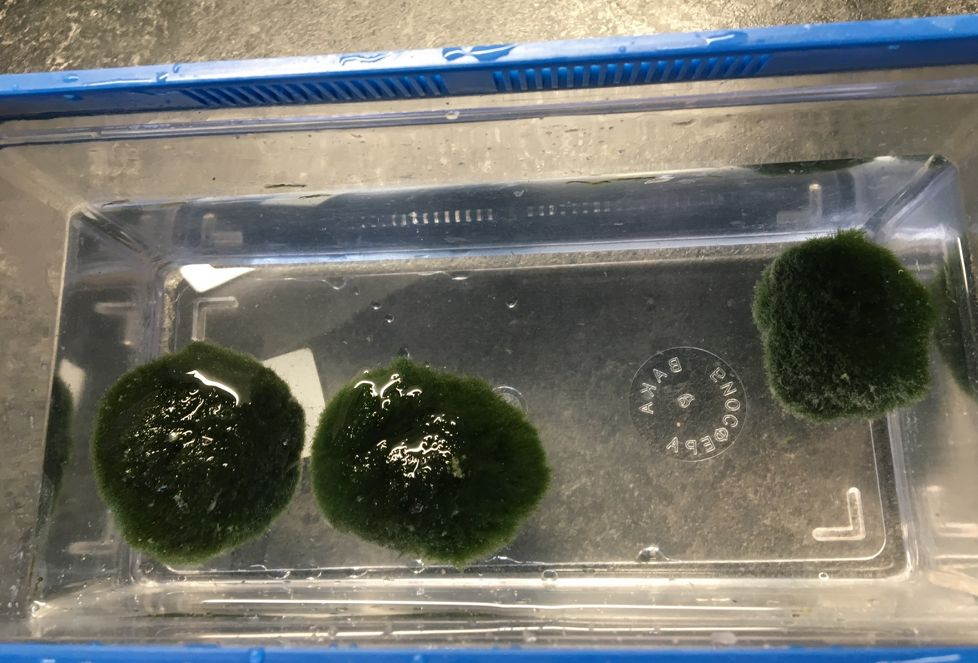
Difficulties in keeping
This is one of the most popular plants among beginning aquarists. Marimo moss balls is the only algae which is very welcome in a tank and its appearance in the indoor or house ponds is always up to their owner wish. The plant is a good looking one, unpretentiousness and moreover it serves as a natural water filter and a shelter for aquarium shrimps.
Keeping the marimo moss ball in nursery tanks is very useful, especially in those where you have fish juveniles which have just recently started to feed actively.
Firstly, the plant is incomparable in terms of its unpretentiousness and efficiency as a natural biological filter, because it perfectly collects dirt; secondly, just like all plants it produces oxygen. Moreover, lots of microorganisms dwell on the plant surface and serve as food for fish juveniles.
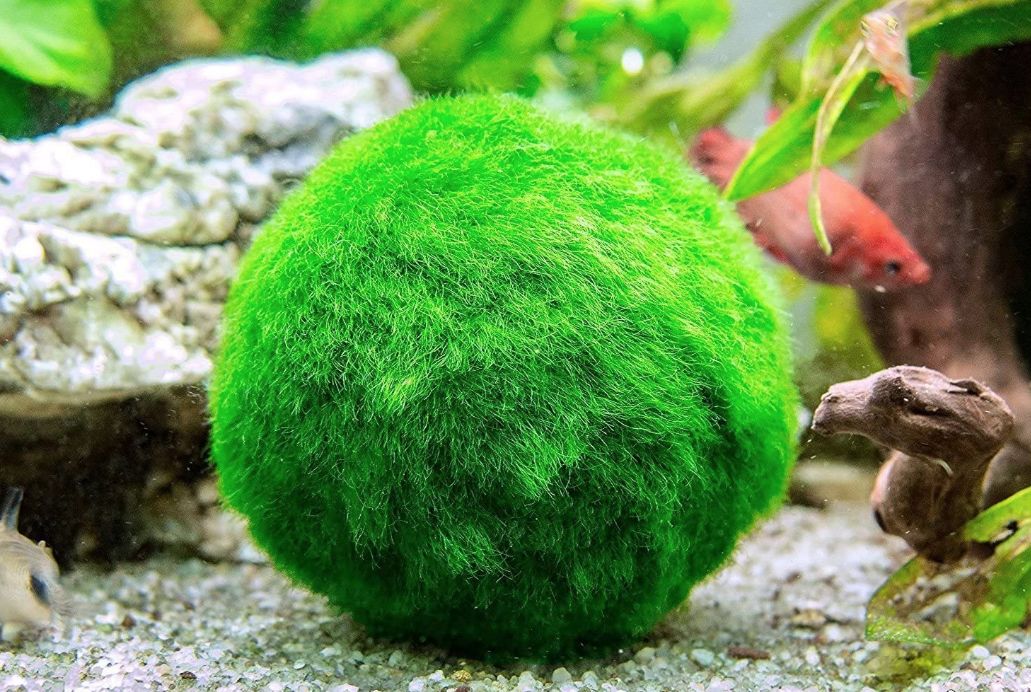
Marimo moss ball care in a aquarium
Water parameters
In tanks marimo moss ball grow well both in soft and hard water. Initially, the future ball looks like something shapeless, but in time it transforms into several bunches growing into different directions.
Then the space between the bunches gets filled with new small plants and the shape gradually becomes spherical. Surprisingly, the colony of plants tends to form a spherical shape anyway. The process is not a fast-developing one and quite often it takes more than a year.
Hydrochemical water parameters have almost no impact on development process. Water pH can vary quite sufficiently in the range from 6.7 to 8.8, though slightly acidic or neutral medium is recommended.
Total hardness of water can be up to 15 dGH. If the water hardness is too high (dGH is higher than 15°) the algae colony slowly degenerates and loses its appealing and attractive appearance.
Temperature
In the wild they are encountered only in cool waters of Ireland or Japan. Therefore, in a tank the plant prefers cold water, correspondingly. If in summer the tank water temperature rises higher than 25 °C, then move the plant to another tank where the water is colder. If you don’t have such a possibility, don’t be surprised when the balls fall into pieces or stop growing.
For successful keeping of marimo moss in a tank you have to meet two main requirements: the tank water temperature should be in the range from 6 to 22 °C and the water renews should be performed as often as possible. In time, some colonies get used to dwelling in warm water (about 24 °C) and without any visible transformations they can live in such a tank for up to 6 month or more.
Theoretically, there is nothing awful if the colony falls into pieces; since each its fragment is a quite viable organism, which later forms a new algae colony. But this is a rather slow paced process and it takes years.
Lighting
Marimo moss is adaptable to a wide range of lighting conditions. It can thrive in low to moderate light environments. Avoid intense or direct sunlight, as it may cause the moss to turn brown or yellowish.
Water Movement
Marimo moss prefers gentle water movement. Provide adequate filtration and ensure water flow is not too strong, as it may dislodge or damage the moss balls.
CO2
While Marimo moss can survive and grow well with the available CO2 levels in aquarium water, some aquarium enthusiasts choose to supplement CO2 to enhance plant growth. Adding supplemental CO2 in a controlled manner can potentially accelerate photosynthesis and lead to increased growth rates for Marimo moss.
Nutrients
Marimo moss can derive nutrients from the water column, and it can also absorb nutrients released from fish waste and decaying organic matter in the aquarium. This makes Marimo moss a valuable addition to the ecosystem, as it helps in nutrient cycling and contributes to water clarity.
Tank mates
There are no peculiarities in the process of keeping in a one tank with higher plants. This algae doesn’t create shadow or stick to anything as well as it doesn’t emit any phytoncides that may depress development of some higher aquatic plants.
You also won’t have any issues with fishes in such a tank. Juveniles like nipping the marimo moss balls surface, but usually they are likely to remove some stuck pieces of food from it. As for the large fish species, they don’t pay any attention to the plant at all.
Cleaning process
As for the outstanding filtration properties of the algae colonies, they are really amazing. When filtrating water the plant captures mud, but at that in time the algae itself starts looking like a piece of mud. Therefore, you shouldn’t expect it to completely replace a water filter in a tank.
If marimo moss balls are clean, it means that the plant is healthy. If you notice that it is covered with dirt somewhere, just wash it with water (it’s better be the tank one), but I’ve already washed it under running cold water.
I even squeezed it a little to get rid of excess of water and yet the plant restored its initial shape and continued growing. However, it is better to treat the plant with care, so put it into a jar and carefully wash it.
In the wild the round shape helps the marimo moss ball follow the water flow along the river bottom, but in a tank this may damage the plant and it may not be able to restore it. Any kind of shrimps will eagerly clean moss, therefore the plant is very welcome in shrimp tanks.
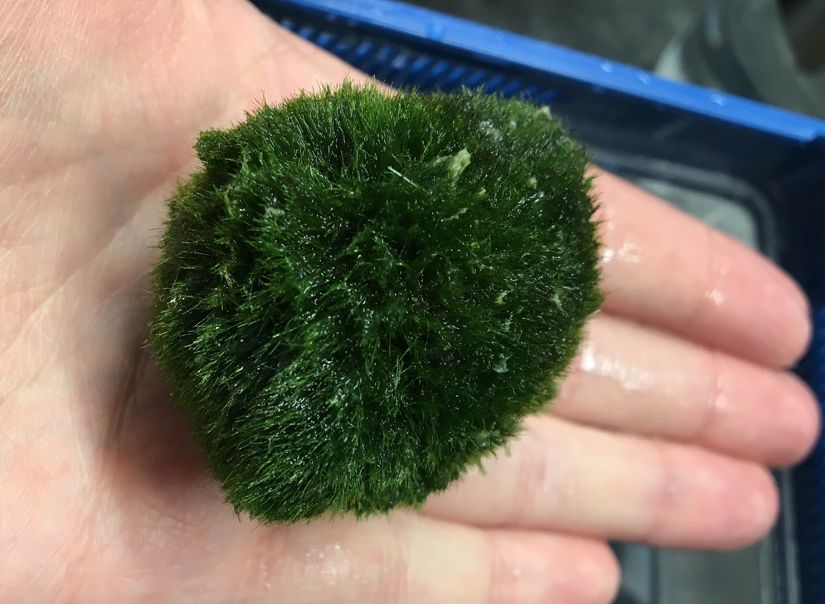
Propagation
The marimo moss ball propagates very easily. It uses vegetative reproduction, i.e. the plant divides into pieces which then form new colonies.
Let’s mention that marimo has rather low growing rate (5 mm in a year), for this reason it is always easier to buy a new plant, than to divide the old one into pieces and wait for along time for a new colony to grow.
The marimo moss ball either falls into pieces naturally, or you can cut it into pieces or trim and then these pieces form a new colony.
In both cases separate fragments of the plant should be put into water with temperature about 18-20 °C and in a year or two the new generation of neat spherical plant colonies will grow.
Sources:
- https://www.science20.com/content/if_you_just_bought_a_marimo_moss_ball_kill_it_with_bleach
- https://www.nature.com/articles/srep03761
- https://www.researchgate.net/publication/335595428_Marimo_machines_oscillators_biosensors_and_actuators
- https://ornamentalfish.org/wp-content/uploads/OATA-Guidance-on-Marimo-Cladophora-moss-balls-and-Zebra-mussels.pdf